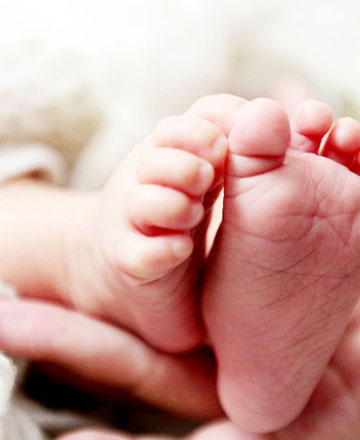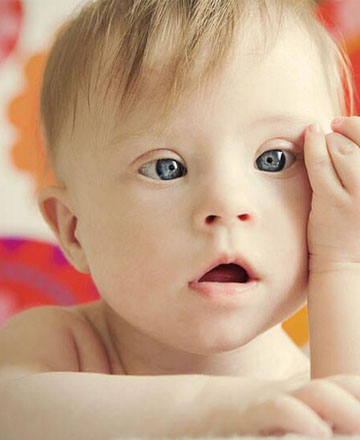

Panorama is a market-leading noninvasive prenatal screening test (NIPT) that reveals your baby’s risk for genetic disorders as early as nine weeks. Panorama analyzes baby's (placental) DNA through a simple blood draw from the mother’s arm.

A low risk result indicates that it is very unlikely that your baby is affected by one of the conditions on the Panorama panel.

A high risk result does not mean the baby has a chromosomal abnormality; rather, it indicates a very high probability that your baby may have that condition. Your healthcare provider may recommend that you speak with a genetic counselor and/ or maternal fetal medicine specialist. You may be offered invasive diagnostic testing such as amniocentesis or CVS. No irreversible pregnancy decisions should ever be made based on a Panorama result alone.

In a small percentage of cases, Panorama may not be able to obtain sufficient information from your blood sample to determine an accurate result. If this occurs, a second blood sample may be requested.
Panorama screens for the most common genetic conditions and the baby’s gender (optional). Some conditions, such as Down syndrome, are caused by extra copies of a specific chromosome. Others, such as microdeletions, occur when a chromosome is missing a small piece of genetic information. Microdeletions affect women equally, regardless of age. Panorama is a screening test. Genetic counseling and diagnostic testing are recommended to confirm positive findings.
A trisomy is a genetic condition caused by extra copies of a chromosome. Down syndrome, one of the most well-known genetic conditions, is caused by an extra copy of chromosome 21. Generally, the larger the extra chromosome is in size, the more severe problems it will cause. For instance, chromosome 21 is the second smallest autosomal chromosome, and babies with Down syndrome often lead healthy and productive lives. However, babies with Trisomy 13, or Patau syndrome, will typically pass away within the first few weeks of life.
Babies with Down syndrome have three copies of chromosome 21 and have intellectual disabilities that range from mild to severe. Children with Down syndrome will need extra medical care depending on the child’s specific health problems. Early intervention has allowed many individuals with Down syndrome to lead healthy and productive lives. The presence of medical conditions, like heart defects, can affect the lifespan in these children and adults; however, most individuals with Down syndrome will live into their 60s. Miscarriage occurs in about 30% of pregnancies with Down syndrome while overall about 1 in 700 babies are born with Down syndrome.
Babies with trisomy 18 have three copies of chromosome 18 and have severe intellectual disabilities and birth defects typically involving the heart, brain, and kidneys. Babies with trisomy 18 can also have visible birth defects such as an opening in the lip (cleft lip) with or without an opening in the roof of the mouth (cleft palate), small head, clubbed feet, underdeveloped fingers and toes, and a small jaw. Unfortunately, most pregnancies with trisomy 18 will miscarry. If born alive, most affected babies with trisomy 18 will pass away within the first few weeks of life. About 10 percent survive to their first birthday. Trisomy 18 occurs in approximately 1 in 3,000 live births.
Babies with trisomy 13 have three copies of chromosome 13 and have severe intellectual disabilities. They often have birth defect involving the heart, brain and kidneys. Visible abnormalities include extra fingers and or toes or an opening in the lip, with or without an opening in the palate. Given the severe disabilities, most pregnancies affected by trisomy 13 will miscarry.If born alive, most affected babies with trisomy 13 will pass away within the first few weeks of life. About 10 percent survive to their first birthday. Trisomy 13 occurs in approximately 1 in 5,000 live births.
Physician orders Panorama.
Blood sample collected.
Sample shipped to Natera and analyzed.
Results sent to physician in about 5 - 7 calendar days.
NIPT: any woman, any age
Since 2012, more than 68,613 patients younger than 35 years of age have been evaluated in eight studies. 28 health plans covering more than 75.1 million lives have updated their medical policies to include NIPTs as medically necessary for fetal aneuploidies in all singleton pregnancies. Panorama is validated in both high- and average-risk cohorts and demonstrates similar positive predictive values (PPV)
Panorama: the power of SNPs
Panorama is the only commercially available NIPT that specifically analyzes single nucleotide polymorphisms (SNPs) to determine chromosome copy number. Validated at fetal fraction as low as 2.8%, this approach sequences cell-free DNA from maternal plasma to infer the fetal genotype. Panorama targets 13,392 SNPs covering chromosomes 21, 18, 13, X, and Y; additional sets of SNPs are targeted for identification of microdeletions.
The importance of fetal fraction
Joint Statement of the American Congress of Obstetrics and Gynecology and the Society for Maternal-Fetal Medicine: “Fetal fraction…is essential for accurate results.” According to the joint statement, failure to measure fetal fraction can increase the chance of a false-negative result. "The ability to differentiate maternal and fetal DNA is reduced at lower fetal fractions." "Detection of subchromosomal microdeletions improves significantly at higher fetal fractions."